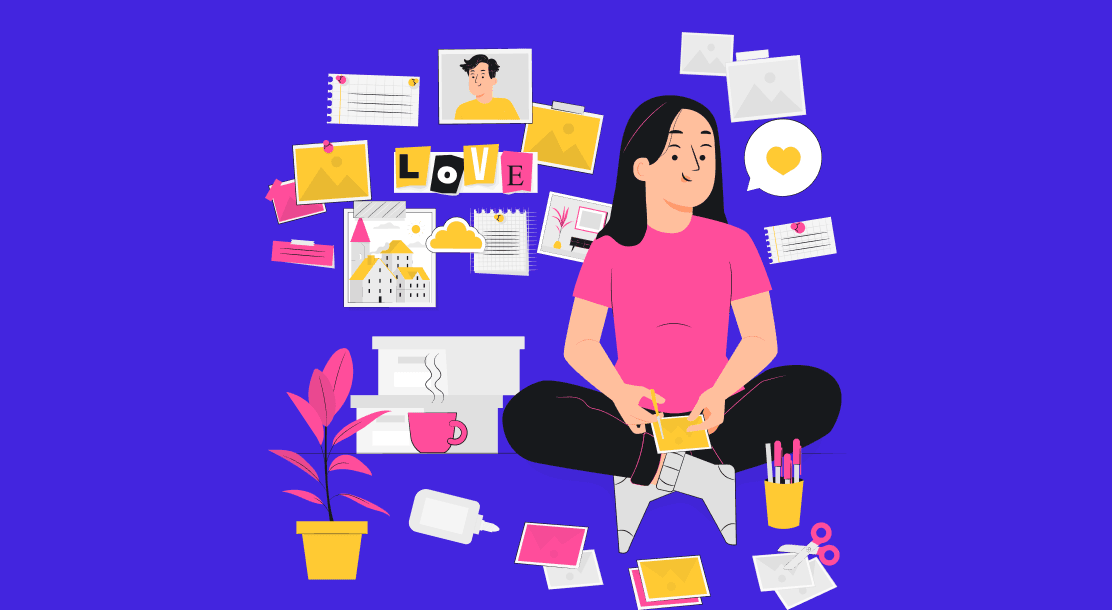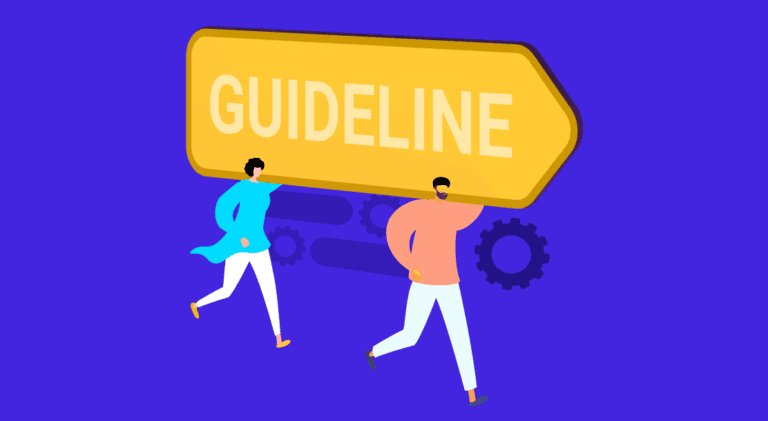What is a Mood Board and How to Create One For Your Brand

Table of Contents
- What is a Mood Board?
- What is a Branding Mood Board?
- Why is a Branding Mood Board Important?
- How to Build Your Brand With a Branding Mood Board
- What to Include in Your Brand Mood Board?
- Key Takeaways
- Conclusion
- FAQs
Every brand owner has a vision. But communicating that to your team or investors and sponsors is not easy. Representing how you envision your brand is an uphill task. This is where visual representation comes in. A mood board is one way of representing your vision in a more tangible form and has been looked upon as an effective tool in marketing. Therefore, it is essential to know what a mood board is and how to create one.
What is a Mood Board?
A mood board can be defined as a visual presentation or collage of images, text, colors, etc., that could be based on a specific topic or a chosen theme. This collection of visual materials, known as a mood board, evokes a particular concept of a vision. They are incredibly efficient and useful in conveying the feel of an idea that might otherwise be difficult to explain in words or text or even through examples. You can organize all your design elements and ideas in one place with the help of a mood board. This helps you visualize your entire concept or story comprehensively and makes it equally possible for others to understand it.
Designers, decorators, wedding planners, filmmakers, professional photographers, and several other creative professionals use mood boards as visual tools to aid them in their work. Now that we know how indispensable mood boards are in branding let’s understand what a branding mood board is.
What is a Branding Mood Board?
Before we jump into the process and start discussing how to make a mood board and what elements it comprises, it is important to understand how a mood board will impact your brand story.
A branding mood board is a collection of visual elements, which could range from colors, text, photographs, doodles, or any other visual inspiration at all.

It encompasses or conveys who you are as a brand and what type of brand message you want to share with your audiences and the world. Your branding mood board is what represents your brand’s visual identity. It could be in the form of a digital collage or an actual physical board where you manually pin-up images, texts, and notes. To put it in simple terms – a branding mood board is what defines the ‘mood’ of your brand.
Why is a Branding Mood Board Important?
If you are wondering what the purpose of this whole activity is and what could be achieved by representing your brand story in terms of visual elements, here is the answer to your question. You can convey your brand vision in the form of words with your team members, colleagues, customers/clients, but there is a high chance that they will never really understand the vibe or feeling you want to evoke.
Mood boards are tools that facilitate the dissemination of that feeling, that general vibe that will help them understand your brand better.
- A branding mood board is created to inspire. If you get stuck during the branding process, a quick look at the mood board will inspire you and might even lead you to a more creative and effective insight at times.
- It helps you communicate better with your team. With a branding mood board, you are on the same page with your entire team. You all can cohesively understand the purpose of your project and work towards it more uniformly with the mood board to guide you.
- A mood board helps you drive brand-related design projects. You can ensure that your final designs are in tune with your brand direction.
- Nothing conveys your brand’s story better than a branding mood board. It is difficult to explain what your brand is, to other people, especially in a few words. Why not show them what your brand is with a branding mood board!

How To Build Your Brand With A Branding Mood Board
Here is a quick guideline on how to create a mood board for your brand:
Step 1: Use Pinterest
Pinterest is the best place to search for mood board inspiration. If you are still unclear on what a mood board is, Pinterest can show you a plethora of mood board examples from different niches and industries. Many individuals also save and share their personal mood boards on Pinterest.

Start on Pinterest and explore palettes and visuals that you find close to what you might be trying to convey through your brand story. Pin anything that stands out or inspires you. Keep noting down or saving the color palettes, images, stylistic details that you find powerful and inspiring- anything at all that you think you could translate into part of your brand. Capture imagery that resonates with your brand ideas or brand story.
Step 2: Narrow down your images
Now that you have your ideas and visuals, to begin with, go through your Pinterest board again. Ask yourself why a specific image stands on your Pinterest board? What does it represent? How close is it to your brand story or your idea? Do this for all the images, typography, everything that you have saved to your Pinterest board.
It is time to narrow down and add notes to each image. Remove the images that are just aesthetically appealing but do not serve any purpose for your brand. You need to write down why you chose each image. If many images clutter a single board, create a second Pinterest board. Add a brand new board if needed.
Step 3: Finalize your mood board
It is now time to finalize your mood board. There is more than one way of creating a mood board today. You can digitally plan and create a mood board if manually creating one is time-consuming and tedious for you. You can use your Pinterest board to create a digital mood board with a graphics program, or you can even take prints of the images you have finalized and add them to a physical mood board.
Focus on how these images are laid out, whether on a digital medium or the actual board. How are they related? Why are they next to each other? Image size, variations, etc., need to be kept in mind. Group or layer images accordingly. Your choice of images conveys your ideas, but your layout communicates your story. Keep this mood board in a place or a folder where you can easily refer back to it when you need inspiration or want to check if you are heading in the right direction with your idea.
Step 4: Make notes
Making notes on the images is important in this stage as well. Capture new themes and visuals that might emerge at this stage of the mood boarding process. Use post-it notes or a diary to note all the inspiration and ideas. Post-it notes come in handy if you create a manual board; you can add them directly over the images and other elements. Pinterest allows you to add notes in caption areas. You can save your final mood board on Pinterest as well if a digital mood board is more convenient for you.
What to Include in Your Brand Mood Board
While your mood board is your personal project and you get to choose what gets included in it or not, some essential elements should ideally be a part of a brand mood board.
- Colors are a prominent element of mood boards. You can look for palettes or individual blocks of colors to add to your mood board. Kuler by Adobe is a tool you can use for choosing colors.
- Patterns are repeating shapes or illustrations that can enhance your mood board and serve as important elements in branding.
- For visual interest, add textures. They can be used as digital graphics.
- Lifestyle images are the best to convey the mood of your entire layout. They will bring your brand mood board to life.
- Illustrations drawn by you or inspired from other mood boards or the Internet can also be added to detail the emotion that the brand mood board conveys.

Key Takeaways
- A mood board is a collection of visual materials. It is used to evoke a specific style of concept.
- A branding mood board is a collection of visual elements, which could range from colors, text, photographs, doodles, or any other visual inspiration at all.
- With a branding mood board, you will have a constant source of inspiration and can communicate better with your entire team. It also helps you drive brand-related design projects.
- Pinterest is the best place to search for mood board inspiration. A lot of individuals save and share their personal mood boards on Pinterest.
- With Pinterest, you can explore palettes and visuals that you find close to your brand story. Pin anything that stands out or inspires you.
- Your choice of images conveys your ideas, but your layout communicates your story.
- You can use your Pinterest board to create a digital mood board with a graphics program, or you can even take prints of the images you have finalized and add them to a physical mood board.
- Post-it notes come in handy if you are creating a manual board; you can add them directly over the images and other elements.

Conclusion
Visual branding is more powerful these days than any other alternative form of branding, and there is nothing better than mood boards for this process. Beautiful and creatively designed mood boards easily communicate the essence of your brand. What is a mood board, after all? It is a cinematic representation of your brand that speaks for itself.
FAQs
While a mood board is a visual tool used for planning aesthetics. It will influence what goes into your inspiration board. A mood board and an inspiration board differ in terms of their elements. A mood board is based on feelings and conceptualization, and an inspiration board is made up of details and specifics about an idea.
Mood boards capture a feeling and attempt at visually representing it. You can include color palettes, patterns, textures, swatches, text, images, and other elements essential in conveying a specific idea or emotion.
Mood boards are creative and inspirational, but one concrete disadvantage tags along with the concept of creating a mood board. A mood board lacks any detailed timeline of an end project. It might not be an effective approach for a detail-oriented project.
Several mood board images are hosted on the web. You can find them on social media accounts, especially on Instagram and Pinterest. Flickr and Picasa also have a vast collection of mood boards.
Some of the best applications for making mood boards include Moodzer, Canva, Jux, Morpholio Board, Pinterest, MilaNote, Go Daddy Studio, Vision Board, etc.
Latest Blogs
Explore how Google’s 2025 AI search updates triggered ranking chaos. Learn actionable strategies to adapt your SEO for AI Overviews, zero-click searches, and SERP volatility. Stay ahead now.
Learn how to rank on AI search engines like ChatGPT, Perplexity, and Gemini by optimizing your content for authority, structure, and relevance. Stay ahead in AI-driven search with this strategic guide.
Explore the best healthcare SEO services for your medical practice. Improve online visibility and effectively reach more patients in need of your services.
Get your hands on the latest news!
Similar Posts

Branding
10 mins read
What Are Brand Guidelines, and How Do They Work?

Branding
8 mins read
Decoding the Branding Strategy of Patanjali

Branding
7 mins read